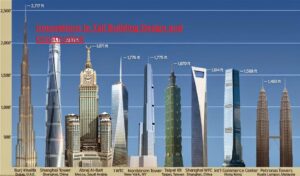Contractors, architects, and designers face unique and tough challenges when building tall establishments that drive structural engineering to its boundaries. As they rise higher and reach the sky, many construction pros encourage creative innovations that adequately uphold huge vertical loads and endure the severe wind and seismic forces at towering heights.
Fresh materials and new establishment procedures are altering and enhancing tall building design and execution. In this blog post, you’ll first explore the common challenges that skyscrapers often encounter as construction begins. Furthermore, we’ll share some solutions to overcome the shared circumstances, making these ever-taller structures feasible and helping the vertical limitations of cities grow.
13 Typical Tall Building Construction Challenges

Skyscraper design and construction is a complicated venture that includes a myriad of circumstances, specifically for its frontline workers—the contractors, architects, and designers. These adversities can affect your project’s performance and the high building’s cost-effectiveness, functionality, aesthetics, and safety. Presented below are some of the difficulties and their effective solutions to help you better prepare once you encounter them:
- Structural Integrity and Safety: One of the high structure concerns is the maintenance of its integrity. Tall buildings should stand firm against different harsh environmental factors, including gravity, wind, and seismic activity, without sacrificing safety. Learn or use your advanced engineering strategies and invest in robust materials to establish a sturdy skyscraper.
- Foundation and Soil Conditions: Your project’s foundation, whether you’re working on a tall building or not, is vital for distributing its weight to the ground. Hence, architects and designers must study and evaluate specific soil conditions at the property’s site. Make sure it’s the most fitting, as inappropriate soil can badly result in settling or collapse if not promptly addressed.
- Wind and Vibrations: As stated, skyscrapers are vulnerable to gusty winds that can cause the structure to sway and vibrate. Designers and architects should enforce innovative construction techniques to defy these adverse effects and guarantee the comfort of the occupants and employees, deterring building damage.
- Vertical Transportation: Establishing a skyscraper is a struggle and risk, starting from transporting essential tools and machinery. Thus, you must invest in efficient vertical transportation utilities, like elevators and escalators, to speed up productivity, secure employees’ safety, and guarantee the tall building’s total quality. Rely on utilities that experts designed to handle the massive traffic while curtailing wait times.
- Mechanical Systems: High-story establishments demand top-notch HVAC systems to maintain excellent temperature and air quality across various floor levels. Incorporating these systems into your skyscraper project’s design is critical for occupants’ convenience. Many industry experts specializing in commercial establishments recommend hiding your HVAC, plumbing, or electrical systems with an access door, like the Babcock-Davis BNP architectural access door, granting safe and smooth access toward your fundamental facilities without compromising the area’s elegant and professional look.
- Space Utilization: Fully utilizing the available space within a tall building while adhering to safety codes and architectural aesthetics is challenging. For enhanced safety and compliance, incorporating fire-rated access hatches is crucial in these structures. Architects and designers must optimize floor layouts for various purposes, from commercial to residential spaces.
- Aesthetics and Urban Integration: Superstructures can remarkably affect the city skyline. The challenge is construction pros, particularly architects, must establish an exceptional balance between the aesthetic appeal of the building and its surroundings—guaranteeing its harmonization within the urban landscape.
- Material Selection: Picking appropriate, durable, and visually alluring materials is paramount. Designers must also think of the product’s cost, weight, sustainability, and maintenance necessities when selecting the materials.
- Construction Logistics: Coordinating the materials, equipment, and personnel logistics in an enclosed urban environment can be demanding. It’s a complex task requiring you to develop adept work schedules that decrease traffic and neighborhood disturbance.
- Regulations and Permits: High-rise building projects mostly demand navigating intricate zoning rules, building regulations, and permits. You and your team must strictly adhere to these legal requirements to avoid work interruptions and other legal issues.
- Cost Management: Tower construction is costly due to the need for unique materials and advanced technologies. Balancing the preferred design with your client’s budget constraints needs careful planning and cost control.
- Sustainability: Nowadays, developing sustainable and energy-efficient tall establishments is becoming increasingly substantial. Thus, architects and designers must integrate green technologies and routines to cut down the building’s environmental footprint remarkably.
- Collaboration and Communication: Successful construction and design of tall buildings stems from effective communication and cooperation among various stakeholders and clients. Everyone should be on the same page to avoid errors and delays.
Every High-Rise Building Problem Comes with Innovative Solutions
Constructing skyscrapers is no easy feat. It requires overcoming challenges like wind forces and vibrations while also balancing aesthetics, sustainability, and safety. But with each hurdle comes a chance to innovate. Through advanced engineering, smooth teamwork, and careful planning, construction pros can build tall buildings that push possibilities. When equal priority is given to beauty and security, skyscrapers become more than just buildings—they become symbols of human creativity. Though it takes effort to reach such heights, the view from the top validates all the work.



